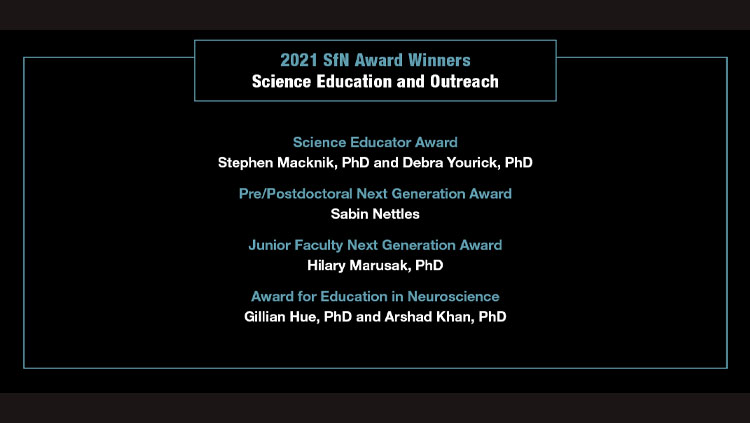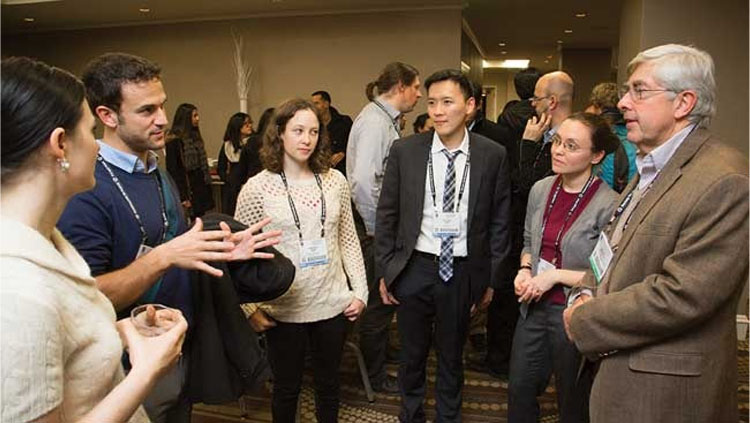BrainFacts.org Spotlight: ‘They Look Like Me’: Why Neuroscience Awards Matter
This article was previously published on BrainFacts.org
Emmys, Grammys, Nobels, Pulitzers, Cy Young Awards, the Golden Boot – we humans relish the opportunity to recognize outstanding achievements of all sorts. Scientists are no different. But, what do brain science awards ultimately mean for the winner, for neuroscience, and for us?
Turns out, a single award can touch multitudes beyond the recipient’s laboratory.
“When people see a prize being awarded [to researchers studying a certain illness] it means that [illness] is being taken seriously and it’s being recognized by the neuroscience community,” says Martin Meyer, scientific program director for The Brain Prize. “This year, The Brain Prize was for work on migraine, which historically has been an underappreciated disorder. It’s really common and it can be devasting for people’s lives, but anyone who doesn’t suffer from migraine can often dismiss it as simply a bad headache.”
The 2021 Brain Prize went to Lars Edvinsson, Peter Goadsby, and Jes Olesen, and Michael Moskowitz for their research that helped push forward several new treatments for the prevention and treatment of migraine, a journey spanning four decades in the making.
“Getting an award at just the right time can be very reinforcing and keeps people in the field and keeps them working.”“Many types of science are very difficult, and you go through long periods in which you don't get many pats on the back,” says Tom Albright, professor, and director of the Vision Center Laboratory at Salk Institute for Biological Studies. “Getting an award at just the right time can be very reinforcing and keeps people in the field and keeps them working.”
Albright co-edits the book series, The History of Neuroscience in Autobiography. In 1991, when Albright received a McKnight Foundation Investigator Award, he felt it brought him into a community of like-minded researchers that was very valuable, especially in the early stages of his career. The recognition and support of your peers is important in any career, including science – awards bolster promotion and new job opportunity potential.
“It’s a way of obtaining recognition within your field of study, and helping that field be noticed by the larger nonscientific community,” says Albright. “Most people who have reached that level of success realize that they got there by standing on other people’s shoulders and that there were many people who contributed to their achievements…”
Adam Smith, chief scientific officer for The Nobel Prize Outreach, reasons the nature of any scientific prize isn’t necessarily to elevate the individuals, but rather the work from a particular field. “If the media do their job and tell the story of the work and not just focus on the individual, then that supports work in the field. And then that, through a series of kind of ripples, goes out to the wider public,” says Smith who is a trained developmental neuroscientist.
“Then people get to know something about the work at the forefront of this field,” Smith says, conveying a prize can do a lot in educating everybody about scientific advances while also creating role models. “Ideally those role models represent the diversity of humanity making it more natural to associate [identify] with these impressive figures.”
Who is awarded can have just as much influence on scientists as it does nonscientists. Though media attention does celebrate individual award recipients, it isn’t inherently wrong to do. However, when the same researchers are awarded with similar gender, racial, and geographic backgrounds, an award intended to represent the field instead embodies its exclusionary history – a white and male dominated space.
A report on trends in the major fields NIH-Ph.D. recipients study suggests more aspiring scientists are entering the fields of neuroscience and neurobiology. However, a paper published in eNeuro this year from NINDS shows that among more than 1400 women and underrepresented minority neuroscientists surveyed, interest in remaining in academia waned over time, while interest in non-academic careers increased.
“They looked like me.”Carla Shatz, director of Stanford Bio-X at Stanford University and an SfN past president, was extremely excited last year when Emmanuelle Charpentier and Jennifer Doudna jointly received the Nobel Prize in Chemistry for the development of a method for genome editing, the precision ‘gene scissors’ known as CRISPR/Cas9. “They looked like me,” Shatz says. “So, when women are recognized for these extremely prestigious awards, I think it’s very meaningful for other younger women in STEM, for example, and women scientists,” says Shatz, also the joint 2015 Gruber Foundation Neuroscience Prize recipient. She shared the $500,000 Gruber prize with Harvard University’s Michael Greenberg.
“Since we're in the era of diversity and equity, I think the prizes are ever more important,” says Shatz. “There have been very few women recognized at the highest levels.” Shatz is also one of the 2016 Kavli Prize Laureates in Neuroscience, sharing the prize with Eve Marder and Michael Merzenich.
Shatz continues, the lack of diversity presents award selection committees and juries with a challenge and an opportunity to dive deeper into learning more about who really contributes to science. “It’s all about networking,” Shatz says. “[If] People remain within their own little comfortable networks, it will never happen [diversity in awardees], but as soon as their networks get more diverse, then there’s this wonderful catalytic effect: diversity yields diversity.”
The proliferation of neuroscience prizes between the late ‘90s and mid-2000s may open the greatest window to change the face of honorees – in turn, changing the face of what scientists look like in the communities that surround them.
In 2020, when Damien Fair began receiving multiple phone calls from a random Chicago area code, he decided to ignore them for the majority of the day. Fair, director at the Masonic Institute for the Developing Brain in the Institute of Child Developing Brain at the University of Minnesota, considered the calls to be spam, but got curious enough to find out who it was.
“It turns out it was the MacArthur Fellowship,” says Fair, who specializes in cognitive neuroscience. “So, I was a little floored.” Coined the “genius grant,” Fair was awarded $625,000 for his work in devising maps of network connectivity in the brain that allows researchers a view of how distinct regions communicate and develop. This year, a MacArthur Fellowship was awarded to Michelle Monje for her work on pediatric brain cancers and the neurological effects of cancer treatment.
In the history of the fellowship, there have been 23 MacArthur fellows with a focus on neuroscience or neurobiology, Fair being one of those recipients. Just before settling into his current position at the University to Minnesota, the killing of George Floyd in Minneapolis by former Minneapolis Police Officer Derek Chauvin was breaking news.
Fair, a Black man and father of a teenage son and young daughter, was navigating difficult conversations at home and in the lab about race and safely managing interactions with police as a person of color.
"...there is an opportunity for us academics to rethink how we’re doing our science..."“I think there is an opportunity for us academics to rethink how we’re doing our science and how, in essence, we ‘touch’ and make the community part of what we do,” says Fair to BrainFacts.org back when his MacArthur Fellowship was announced. “… A lot of the work that we do is related to stress and anxiety and how that affects brain development in this environment that we’re living in. It has huge impacts on how the brain develops, how you interact, and what the future looks like for a lot of folks.”
Fair plans to use his prize, in part, to work on a shared vision with his wife, urogynecologist Rahel Nardos, director of Global Women’s Health at the Center for Global Health and Social Responsibility at the University of Minnesota. Fair says that they want to build programs to make their work more accessible to underrepresented populations in the U.S. and developing countries. As it is for many awardees, Fair’s MacArthur Fellowship isn’t just his. As the epicenter of the award’s impact, Fair can focus on work that will benefit his field and his community.



















